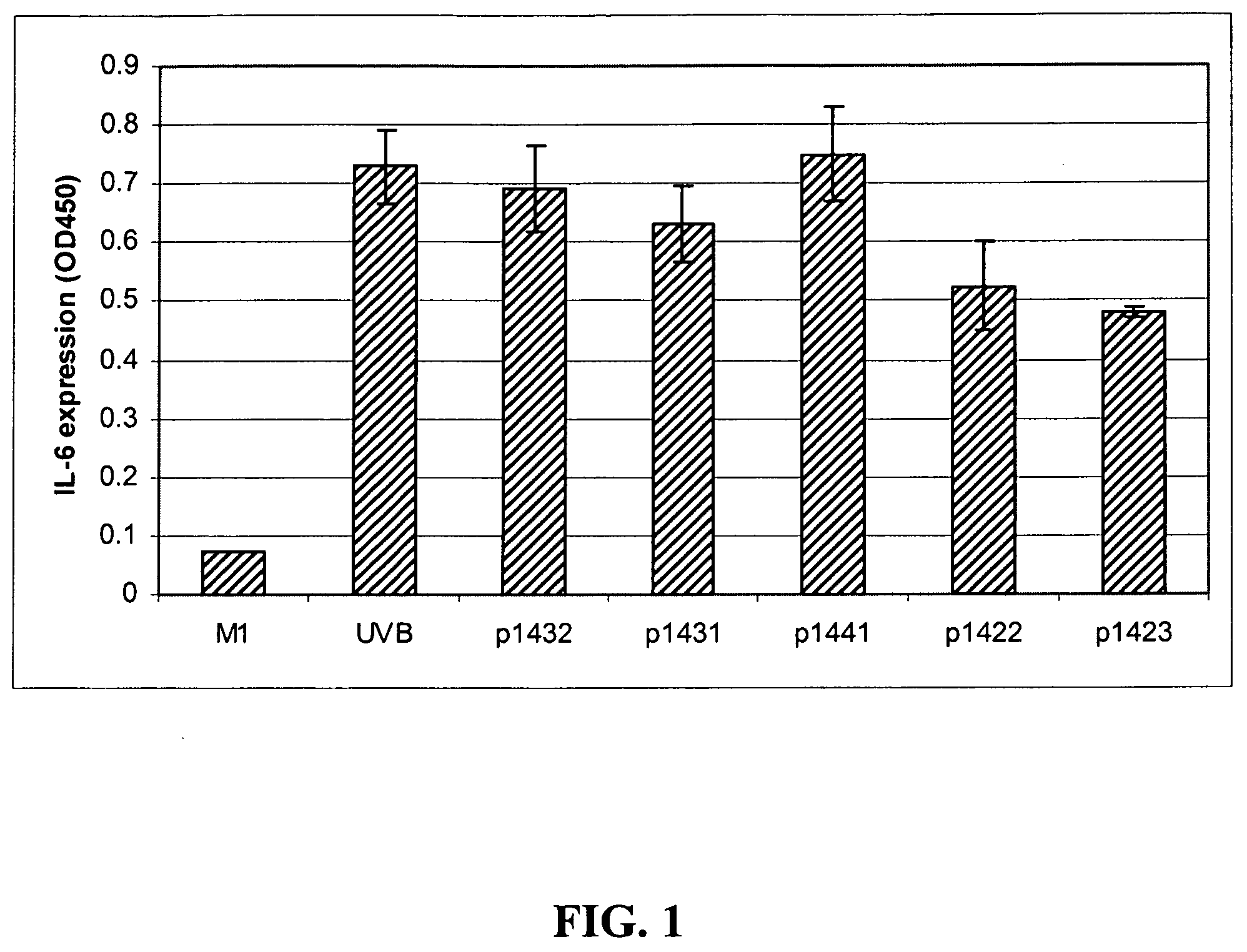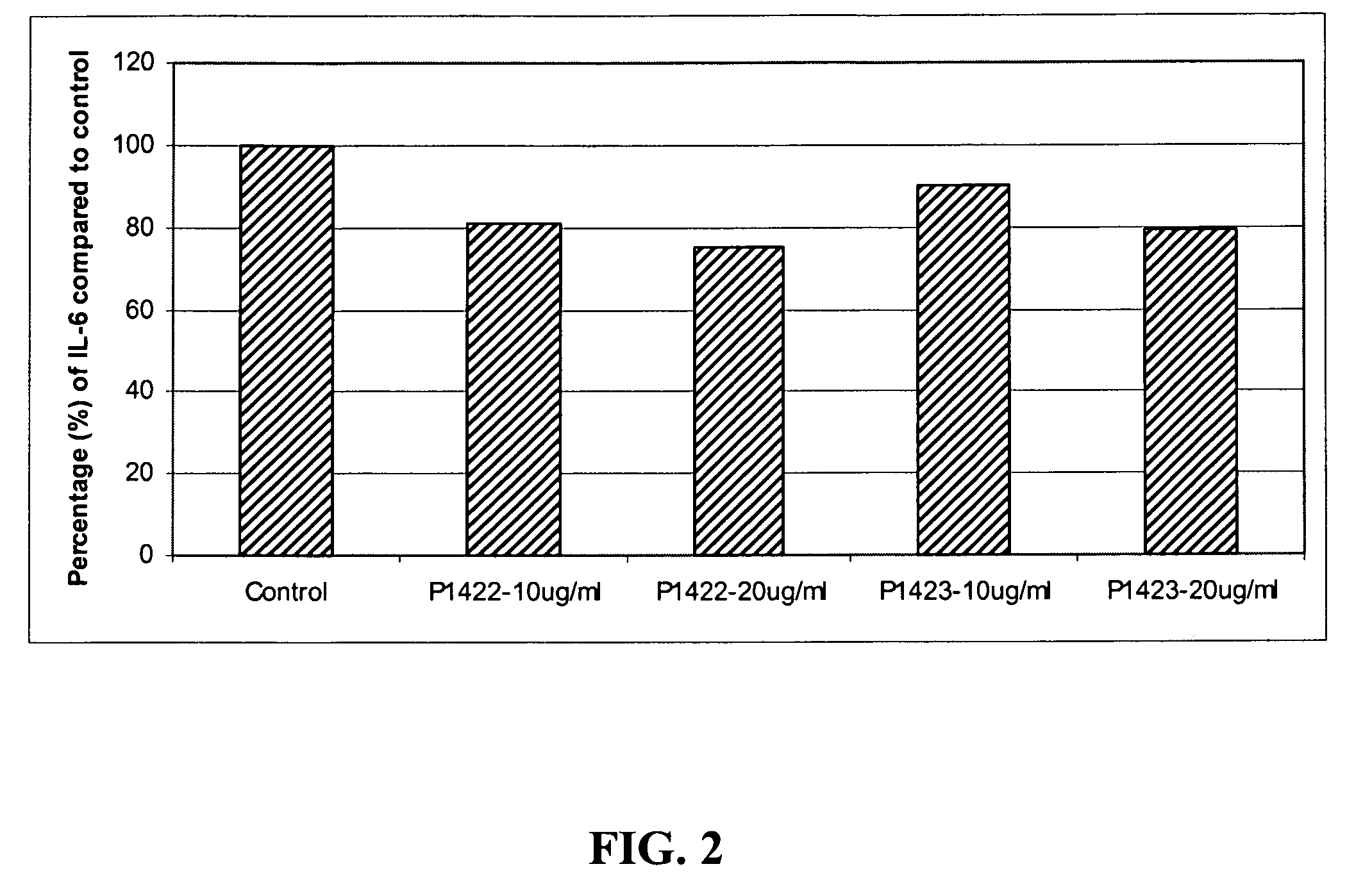Protective skin care peptides
- Summary
- Abstract
- Description
- Claims
- Application Information
AI Technical Summary
Benefits of technology
Problems solved by technology
Method used
Image
Examples
example 1
Design and Synthesis of Peptides that are Related to the PXQXX-(Aromatic / Acidic) (SEQ ID NO:16) Peptide.
[0056]The rational for designing the inventive peptides involved the following parameters:[0057]1. Peptides are only four amino acids in length (i.e., tetrapeptides less than 500 Daltons).[0058]2. Sequences are selected from the conserved binding domain [PXQXX-(aromatic / acidic)] (SEQ ID NO:16) of TRAF6-binding proteins.[0059]3. Tetrapeptide sequences conserve the proline in position 1 and the glutamate in position 3 of PXQXX-(aromatic / acidic) (SEQ ID NO:16).[0060]4. Positions 2 and 4 are assigned amino acid residues that exist at these sites in naturally occurring forms of PXQXX-(aromatic / acidic) (SEQ ID NO:16):[0061]a. Position 2: Q, T, L, G, E, V or P.[0062]b. Position 4: I, M, D, V, N, S or T.[0063]5. To create additional variation, a positively charged residue was also used in position 4; such an amino acid placement has been avoided in nature.
[0064]Peptide synthesis: All pept...
example 2
Cell Cultures and Detection of IL-6 and MMP-1.
[0066]Human skin epithelial cells (ATCC CRL-2592), keratinocytes (ATCC CRL-2404) and skin fibroblasts (ATCC CRL-7481) were employed in the study. Cells were seeded into 6-well plates and allowed to grow to >95% confluence in Dulbecco's modified Eagle's medium (DMEM; 4 mM L-glutamine, 4.5 g / L glucose) adjusted to contain 1.5 g / L sodium bicarbonate and supplemented with 10% fetal bovine serum (FBS). For keratinocytes, cells were grown in keratinocyte growth media (without serum) supplemented with 5 ng / mL human recombinant epithelial growth factor (EGF; Invitrogen, Grand Island, N.Y.). After the cell monolayer reached >95% confluence, the cells were serum-starved or EGF-starved for 24 hours in complete medium without serum. UVA or UVB was generated using a UVLMS lamp (4-W model, 3UV assembly; Upland, Calif.) with the irradiation wavelength set at 365 or 302 nm, respectively. The UV lamp was placed 15 cm above the tissue culture plate. Befor...
example 3
Screening Peptides for Anti-inflammatory Activity: Inhibition of UV-induced IL-6 Expression in Human Skin Epithelial Cells.
[0067]As shown in FIG. 1, human epithelial cells upregulate IL-6 expression in response to UVB irradiation. All the tetrapeptides listed in Table I were subjected to a screening test at 40 μg / mL for potential down-regulation of this response (data not shown). Those peptides that down-regulated IL-6 expression in a first experiment were retested in a second experiment, the results of which are shown in FIG. 1.
[0068]Both tetrapeptides P1422 (SEQ ID NO:1) and P1423 (SEQ ID NO:2) at 40 μg / mL showed reproducible repression of UVB-induced IL-6 expression in skin epithelial cells. As shown in FIG. 2, such down-regulation was concentration-dependent for both these peptides. P1422 (SEQ ID NO:1) reduced IL-6 levels by 19% and 25% at 10 and 20 μg / mL, respectively; and P1423 (SEQ ID NO:2) reduced IL-6 levels by 10% and 20% at 10 and 20 μg / mL, respectively. The fact that the...
PUM
| Property | Measurement | Unit |
|---|---|---|
| Concentration | aaaaa | aaaaa |
| Concentration | aaaaa | aaaaa |
| Time | aaaaa | aaaaa |
Abstract
Description
Claims
Application Information
 Login to View More
Login to View More - R&D
- Intellectual Property
- Life Sciences
- Materials
- Tech Scout
- Unparalleled Data Quality
- Higher Quality Content
- 60% Fewer Hallucinations
Browse by: Latest US Patents, China's latest patents, Technical Efficacy Thesaurus, Application Domain, Technology Topic, Popular Technical Reports.
© 2025 PatSnap. All rights reserved.Legal|Privacy policy|Modern Slavery Act Transparency Statement|Sitemap|About US| Contact US: help@patsnap.com



